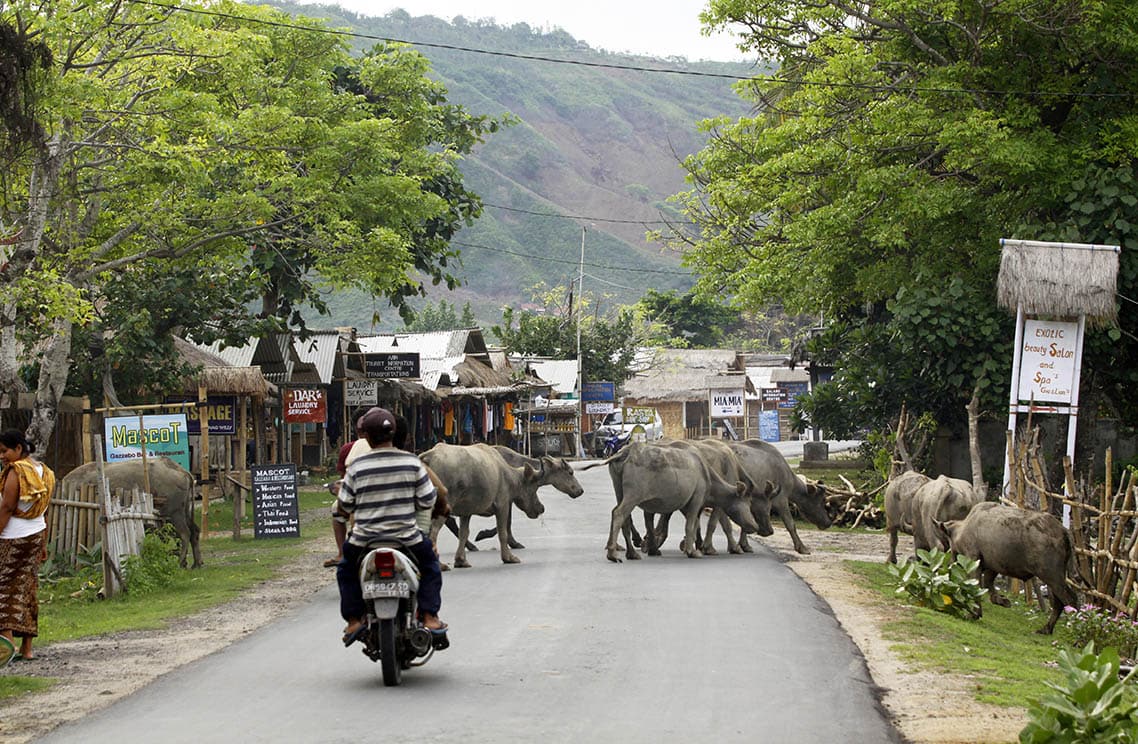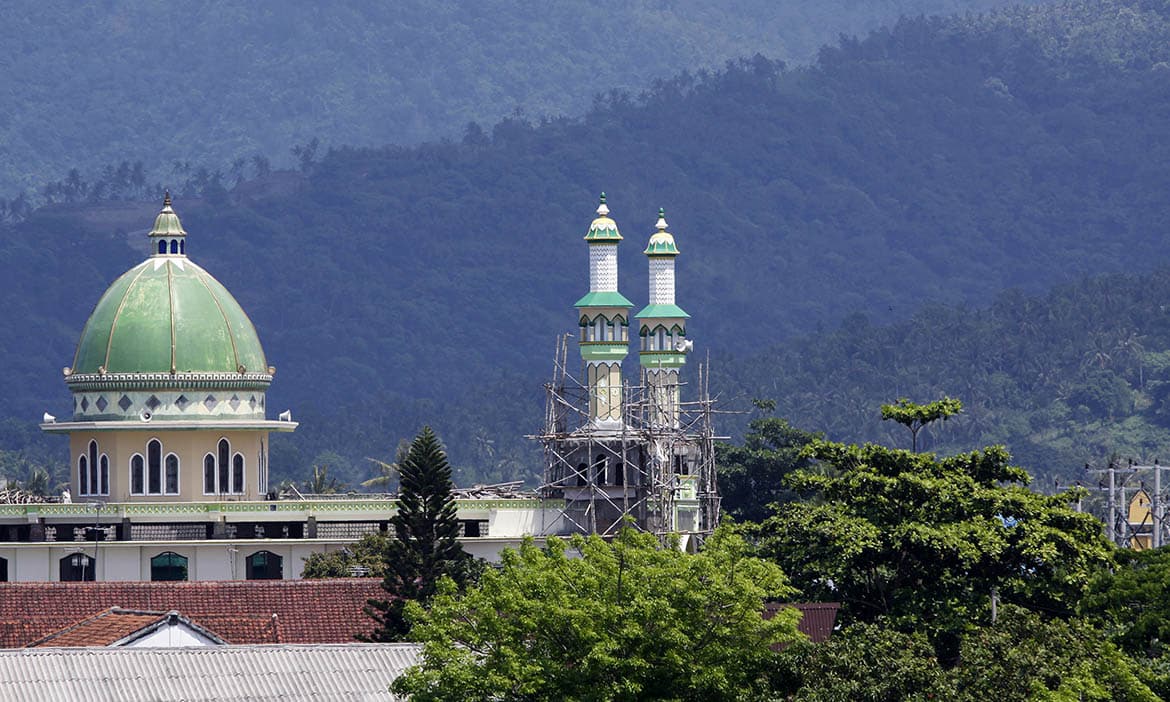Leisurely Lombok
For many travellers, the island of Lombok is unchartered territory. I eagerly anticipated landing at the Indonesian island’s Bandara International Airport, having heard so much about a place that resembled Bali.
Direct flights from Kuala Lumpur always make getaway destinations more appealing, especially for those seeking a short holiday break during a long weekend. Lombok’s relative isolation was what was so appealing to me especially since the island is far less visited than its neighbour, Bali.

Even on popular Senggigi Beach, there are uncrowded sections for complete relaxation.
In many ways, Lombok is like Bali, but the two islands are so different in both culture and religion. This is to ensure that Lombok does not become as overrun as Bali. As such, Lombok has less developed tourism infrastructure. However, this is what made it so appealing to me. Many parts of Bali have become far too touristy and overcrowded for my taste.
Lombok was in the news recently after a destructive earthquake did considerable damage especially in the north of the island. Lives were lost, property damaged, and lives dislocated. The best way for tourists to help the island is to return and holiday in Lombok. The good news is that most tourist destinations on the west and south coast suffered minimal damage.
The ‘Other’ Kuta
Resorts along Kuta Beach in the south and Senggigi in the west are only 30-minutes from the airport. Senggigi is the main tourist precinct while the beautiful beaches of Kuta are yet to be fully discovered.

Lombok’s Kuta Beach offers a relaxed pace of life and safe swimming conditions.
There are two Kuta’s in this part of the world. Firstly, there’s the famous, raucous, and crowded Kuta Beach in Bali. Then there’s the serene, near-deserted, and leisurely Kuta Beach in the south of Lombok. The second one being the perfect place for those seeking a more laid-back retreat.
Many travellers who venture to Kuta are backpacking surfers. They come to ride the challenging breaks off one of several reefs along Lombok’s southern coast. The restaurants and bars in Kuta reflect its laid-back ambience. However, there is an increasing number of outlets that now attract a more affluent crowd.
Kuta Beach appeals to those who like to relax by the beach. It is without the crowds, touts, and general hassle that has become a prominent feature in other islands.

Water buffalo have right of way in Kuta Village.
Remote and Relaxing
The Novotel Lombok Resort and Villa gives the impression that you almost have the place to yourself. It has only 102 rooms and villas (ten private villas and ten private pool villas). Its earth-coloured exterior walls with exposed timber and stone, built in local Sasak style, provide a rustic setting.

Novotel Lombok Resort offers both rooms and villas located in tropical gardens.
The resort resembles a village of adobe huts but the attap roofs provide a local architectural reference that is typical of the Sasak people who call Lombok home. The typical local style is the high thatched roof, rice barn called lumbung and best seen in the resort’s villas or the village of Sade on the main road from the airport to the resort.

On the island, rice is stored in Sasak rice houses.
My room in the resort was furnished with everything I required including cable television and wi-fi to keep me in contact with the outside world, which seemed very distant from my relaxed location.
The adjoining village of Kuta had all I needed including a few smart restaurants, local warungs, some bars, and some shops. I especially enjoyed the international and Indonesian fare served at The Other Place Restaurant and Tomato Café.

Guests at the Novotel can swim at the beach or in four resort pools.
Peaceful and Calming
Kuta is on a sweeping bay that is lined every morning with a smattering of seaweeds. I later discovered that these are harvested, dried, and used in the production of many different types of products from ice cream to shampoo. This bay is safe for swimming as an offshore reef protects it. The faint sound of crashing waves lulled me to sleep beneath shaded beachside shelters.
The Novotel Lombok has fantastic facilities with most guests appear content to stay in-house and indulge in the spa and dine in one of two restaurants. My favourite spot was the Breeze Bar for its early evening happy hours where an open-sided bar serves cool drinks close to the sand. Guests can dine in either Spice Market Restaurant or Vue Restaurant with the latter, a little more elegant and romantic with fresh seafood specialities.

Swim in the clear waters off Kuta or take a boat to remote surfing beaches.
Lombok Explorer
Lombok forms part of Indonesia’s Nusa Tenggara Province within the Lesser Sunda Islands and the Lombok Strait separates the island from Bali to the west.
Tourists are attracted to Lombok for its cultural features, scenic landscapes, and because it is not very commercialised. Others travel to the island to climb the island’s peak of Mount Rinjani (3,726 m) that is visible from many parts of the island. The locals told me that this was no walk in the park and should only be attempted by fit, experienced, and well-equipped climbers. Most walks are three days/two nights camping on a mountain that can get cold, cloudy, windy, and difficult underfoot with volcanic sand. Anyone attempting the climb also needs to check whether the trails are open. Some sections of the park have been closed after the 2018 earthquake.
Lombok Scene
Senggigi Beach is the main beach precinct on the island and the one where those who like a little action, nightlife, and entertainment should stay. I didn’t stay here but hired a car and driver in Kuta to explore the island. I visited the main town of Mataram, a local market in Sengkol, a traditional village called Sade, and Senggigi Beach. The best view of Senggigi is from Batu Bolong Temple located high above the coast.
The Oberoi Lombok is one of the finest and well-established resorts along the long beachfront. I planned to be here at the end of the day because I heard about Lombok’s legendary sunsets. I enjoyed a chilled sundowner at the Tokek Bar before having an early dinner at the Sunbird Café. The food served here is a blend of Western comfort food and Indonesian favourites. While admiring a distant view of Mount Agung on neighbouring Bali, I can only imagine how luxurious the rooms and villas here must be.
Lombok Culture
The Islanders differ from the Balinese in that the Sasak people (85% of Lombok’s residents) who live here are mostly Muslims. Mosques are a more common sight than the Hindu temples of Bali. I passed many mosques in rural settings. I also visited Lingsar Hindu Temple where the locals were fishing in an adjoining pond.

Unlike Bali, which is predominantly Hindu, the people of Lombok are mostly Muslim.
Many people on Lombok are farmers with the main crop of rice grown in rich volcanic soil. Other crops grown include corn, coffee, soybeans, tobacco, cotton, peanuts, and vanilla.
Colourful and traditional wooden fishing boats (called perahu) line many of the beaches. These are approximately 5-metres long and use a single main cloth sail to project them across the water. Bamboo outriggers on both sides provide stability in the open sea.

Tourists use Lombok’s fishing boats for diving and snorkelling trips.
Arriving
Travelling to Lombok once meant a change of plane in Bali or taking a ferry across the Lombok Strait, but now it is possible to fly direct from Kuala Lumpur. Malaysians don’t have to pay an arrival tax but some other nationals have to. You will also need to pay a departure tax when leaving the island.
I asked my accommodation to arrange a transfer for me to my beachside home for much of my stay on Lombok.
David Bowden is the author of the book Enchanting Bali & Lombok published by John Beaufoy Publishing (www.johnbeaufoy.com), which is sold in all good bookshops in Malaysia and the region.